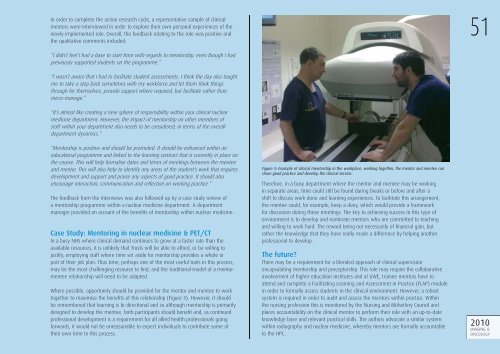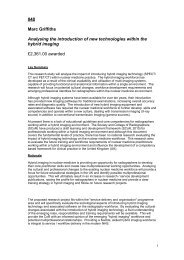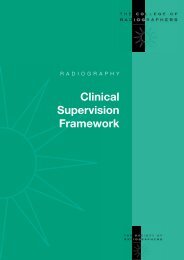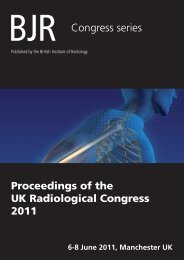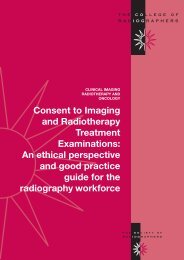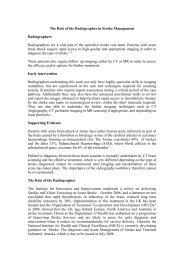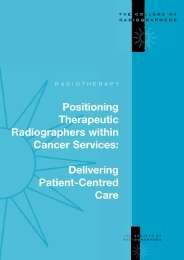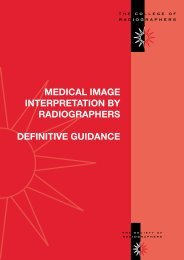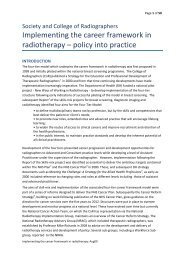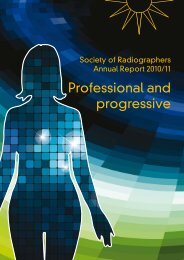IMAGING & ONCOLOGY - Society of Radiographers
IMAGING & ONCOLOGY - Society of Radiographers
IMAGING & ONCOLOGY - Society of Radiographers
- No tags were found...
Create successful ePaper yourself
Turn your PDF publications into a flip-book with our unique Google optimized e-Paper software.
In order to complete the action research cycle, a representative sample <strong>of</strong> clinicalmentors were interviewed in order to explore their own personal experiences <strong>of</strong> thenewly implemented role. Overall, the feedback relating to the role was positive andthe qualitative comments included:51“I didn’t feel I had a base to start from with regards to mentorship, even though I hadpreviously supported students on the programme.”“I wasn’t aware that I had to facilitate student assessments. I think the day also taughtme to take a step back sometimes with my workforce and let them think thingsthrough for themselves, provide support where required, but facilitate rather thanmicro-manage.”“It’s almost like creating a new sphere <strong>of</strong> responsibility within your clinical nuclearmedicine department. However, the impact <strong>of</strong> mentorship on other members <strong>of</strong>staff within your department also needs to be considered, in terms <strong>of</strong> the overalldepartment dynamics.”“Mentorship is positive and should be promoted. It should be enhanced within aneducational programme and linked to the learning contract that is currently in place onthe course. This will help formalise dates and times <strong>of</strong> meetings between the menteeand mentor. This will also help to identify any areas <strong>of</strong> the student’s work that requiresdevelopment and support and praise any aspects <strong>of</strong> good practice. It should alsoencourage interaction, communication and refl ection on working practice.”The feedback from the interviews was also followed up by a case study review <strong>of</strong>a mentorship programme within a nuclear medicine department. A departmentmanager provided an account <strong>of</strong> the benefi ts <strong>of</strong> mentorship within nuclear medicine:Case Study: Mentoring in nuclear medicine & PET/CTIn a busy NHS where clinical demand continues to grow at a faster rate than theavailable resources, it is unlikely that Trusts will be able to afford, or be willing tojustify, employing staff where time set aside for mentorship provides a whole orpart <strong>of</strong> their job plan. Thus time, perhaps one <strong>of</strong> the most useful tools in this process,may be the most challenging resource to fi nd, and the traditional model <strong>of</strong> a mentormenteerelationship will need to be adapted.Where possible, opportunity should be provided for the mentor and mentee to worktogether to maximise the benefi ts <strong>of</strong> this relationship (Figure 3). However, it shouldbe remembered that learning is bi-directional and so although mentorship is primarilydesigned to develop the mentee, both participants should benefi t and, as continuedpr<strong>of</strong>essional development is a requirement for all allied health pr<strong>of</strong>essionals goingforwards, it would not be unreasonable to expect individuals to contribute some <strong>of</strong>their own time to this process.Figure 3: Example <strong>of</strong> clinical mentorship in the workplace, working together, the mentor and mentee canshare good practice and develop the clinical service.Therefore, in a busy department where the mentor and mentee may be workingin separate areas, time could still be found during breaks or before and after ashift to discuss work done and learning experiences. To facilitate this arrangement,the mentee could, for example, keep a diary, which would provide a frameworkfor discussion during these meetings. The key to achieving success in this type <strong>of</strong>environment is to develop and nominate mentors who are committed to teachingand willing to work hard. The reward being not necessarily <strong>of</strong> fi nancial gain, butrather the knowledge that they have really made a difference by helping anotherpr<strong>of</strong>essional to develop.The future?There may be a requirement for a blended approach <strong>of</strong> clinical supervisionencapsulating mentorship and preceptorship. This role may require the collaborativeinvolvement <strong>of</strong> higher education institutes and at UWE, trainee mentors have toattend and complete a Facilitating Learning and Assessment in Practice (FLAP) modulein order to formally assess students in the clinical environment. However, a robustsystem is required in order to audit and assess the mentors within practice. Withinthe nursing pr<strong>of</strong>ession this is monitored by the Nursing and Midwifery Council andplaces accountability on the clinical mentor to perform their role with an up-to-dateknowledge base and relevant practical skills. The authors advocate a similar systemwithin radiography and nuclear medicine, whereby mentors are formally accountableto the HPC.2010<strong>IMAGING</strong> &<strong>ONCOLOGY</strong>


